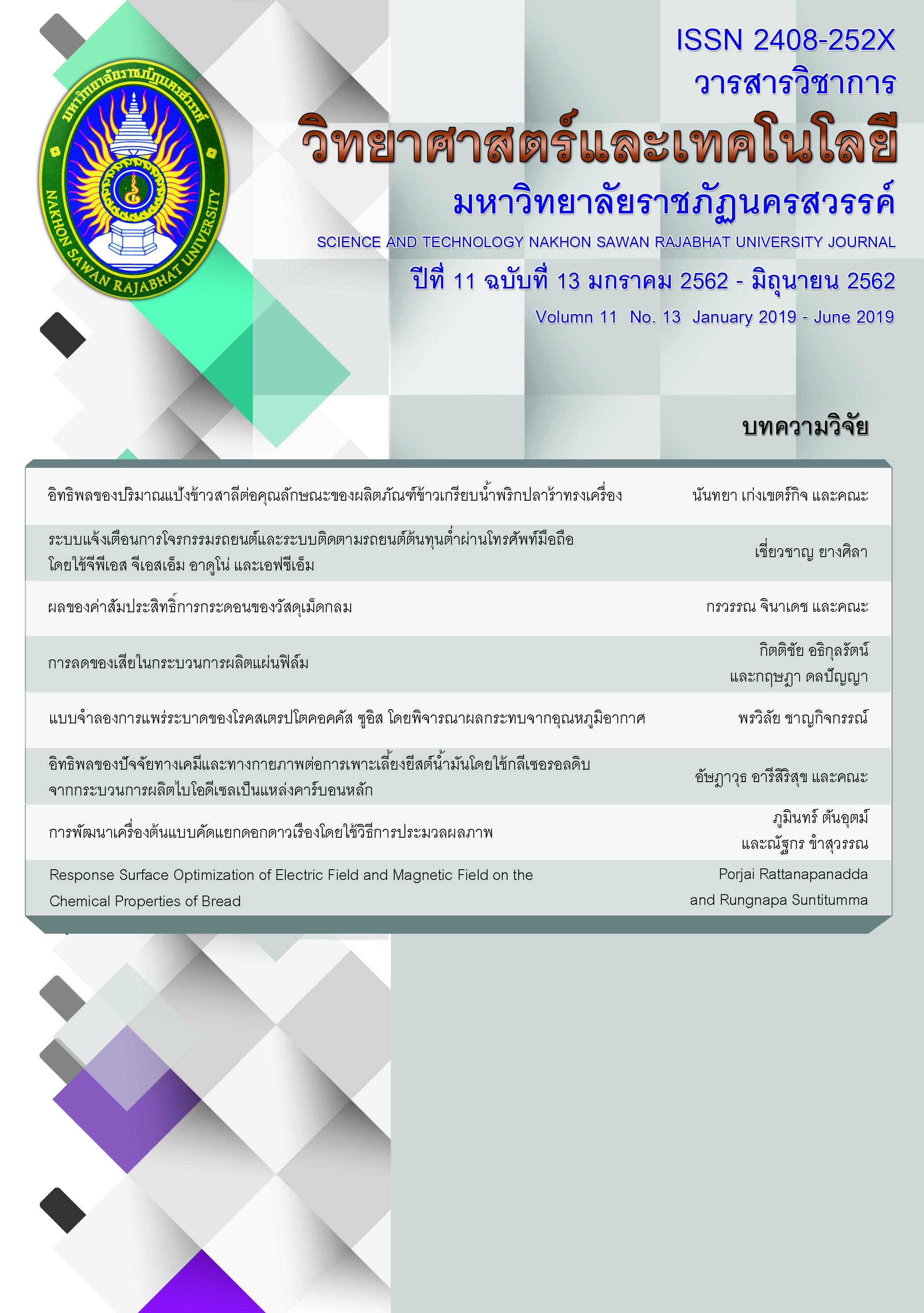Response surface optimization of electric field and magnetic field on the chemical properties of bread
Main Article Content
Abstract
The objectives of this research are to examine the effect of the electric field and magnetic field on the moisture content and water activity of bread. We studied how the electric field (0-8 KV), magnetic field (0-1400 mT) and treatment time (0-2 hrs.) affect the moisture content and water activity of bread. The effects of moisture content and water activity on bread were determined. Response surface methodology (RSM) based on three factor three level central composite design was applied to determine the effect of electric field level, magnetic field level and treatment time. A second-order polynomial model fitted well to the experimental data (R2=0.9854 and 0.9737) for moisture content and water activity, respectively. Significant moisture content and water activity were observed at the maximum treatment conditions of 8 KV of electric field, 1400 mT of magnetic field and treatment time 2 hrs., indicating stability of moisture content and water activity in bread. The main factor was electric field. The coefficients of moisture content were 0.2951 for electric field and 0.001579 for magnetic field. It was related with coefficients of water activity, which were 0.01159 and 0.000024 for electric field and magnetic field, respectively. The interaction of electric field and magnetic field was no significant for moisture content and water activity in bread.
Article Details
References
Baumann, J.W. (1981). Application of enzymes in fruit juice technology. In Birch, G.G., Blakebrough, N. & Parker, K.J. (Eds.), Enzymes and food processing. London: Applied Science Publication.
Cai, R., Yang, H., He, J. & Zhu, W. (2009). The effects of magnetic fields on water molecular hydrogen bonds. Journal of Molecular Structure, 938 (1-3), 15-19.
Cassone, G., Giaquinta, P.V., Saija, F. & Saitta, A. M. (2014). Proton conduction in water ices under an electric field. Journal of Physical Chemistry, 118 (16), 4419-4424.
Cochran, W.G. & Cox, G.M. (1957). Experimental designs (2nded.). New York: John Wiley and Sons Inc.
Dean, A.M. & Voss, D.T. (1999). Design and analysis of experiments. New York: Springer.
Fojt, L., Strasak, L., Vetterl, V. & Smarda, J. (2004). Comparison of the low-frequency magnetic field effects on bacteria Escherichia coli, Leclercia adecarboxylata and Staphylococcus aureus. Bioelectrochemistry, 63 (1-2), 337-341.
Giovanni, M. (1983). Response surface methodology and product optimization. Food Technology, 37 (11), 41- 45.
Kent, N.L. (1975). Technology of cereals, with special reference to wheat, (2nd ed.). Oxford, UK: Pergamon Press.
Labuza, T.P., Mc. Naly, L.D., Gallagher, J., Hawkes, I. & Hurtado, F. (1972). The stability of intermediate moisture food. Journal of Food Science, 37 (1), 154.
Lee, W.C., Yusof, S., Hamid, N.S.A. & Baharin, B.S. (2006). Optimizing conditions for hot water extraction of banana juice. Journal of Food Engineering, 75 (4), 473-479.
Liu, S., Yang, F., Zhang, C., Ji, H., Hong, P. & Deng, C. (2009). Optimization of process parameters for supercritical carbon dioxide extraction of Passiflora seed oil by response surface methodology. Journal of Supercritical Fluids, 48 (1), 9–14.
Luciana, D. & Luigi, A. (2005). Bioeffects of moderate-intensity static magnetic fields on cell culture. Micron, 36 (3), 195-217.
Mason, R.L., Gunst, R.F. & Hess, J.L. (1989). Statistical design and analysis of experiments: With applications to engineering and science wiley series in probability and mathematical statistics. New York: John Wiley and Sons.
Montgomery, D.C. (1991). Design and analysis of experiments. New York: Wiley & Sons.
Novak, J., Strasak, L., Fojt, L. Slaninova, I. & Vetterl, V. (2007). Effect of low-frequency magnetic fields on the viability of yeast Saccharomyces cerevisiae. Bioelectrochemistry, 70 (1), 115-121.
Perkins-Veazie, P., Collins, J.K., Pair, S.D. & Roberts, W. (2001). Lycopene content differs among red-fleshed watermelon cultivars. Journal of Science Food Agriculture, 81 (10), 983–987.
Pomeranz, Y. (1987). Modern cereal science technology. New York: VCH Publishers.
Rödel, W., Krispien, K. & Leistner, L. (1979). Measuring the water activity (aw-value) of meat and meat products. Fleischwirtschaft, 59 (6), 849–851.
Saitta, A.M., Saija, F. & Giaquinta, P.V. (2012). Ab initio molecular dynamics study of dissociation of water under an electric field. Physical Review Letters, 108, 1-5.
Varachai, T. (2011). Changing world population 1950-2030. Thailand: Mahidol University.
Wang, Y., Zhang, B., Gong, Z., Gao, K., Ou, Y. & Zhang, J. (2013). The effect of a static magnetic field on the hydrogen bonding in water using frictional experiments. Journal of Molecular Structure, 1052, 102-104.
Wei, S., Xiaobin, X., Hong, Z. & Chuanxiang, X. (2008). Effects of dipole polarization of water molecules on ice formation under an electrostatic field. Cryobiology, 56 (1), 93-99.
WHO. (2006). Static fields environmental health criteria monograph No.232. Retrieved from http://www.wh o.int2peh -emf/publications/EHC_232_Static_Fields_full_document .pdf.


